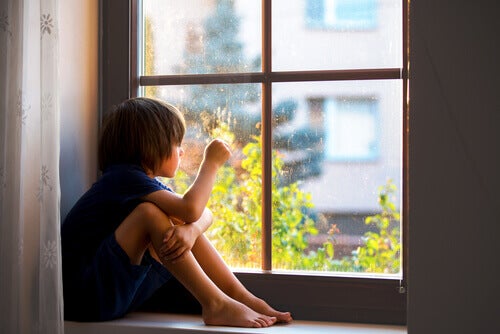Separation anxiety is a state in which our little ones can stay and has the power to significantly affect their daily lives, we all know the problems that anxiety can bring to adults, don’t we?Not only in relation to our mental well-being, but also in relation to our physical sensations. Now can you imagine the influences this feeling can have on a child, whose ability to regulate their emotions is much less?
The reality is that, unfortunately, children can develop emotional states that make their childhood a very sad time, even if they have the potential to do the exact opposite. references don’t abandon them when they leave.
“It’s never too late to have a happy childhood. – Tom Robbins-
Separation anxiety arises from children’s fear of separating from their parents or attachment figures, the reality is that it is normal for this emotion to appear in young children, but it is also normal for it to disappear in a short time. the parents leave, but they also return, he ends up normalizing the separation, they begin to suffer it not as an abandonment, but only as a temporary absence, but when and how can a problem really arise?
This anxiety is harmful when it is very intense or when the separations are not normal at all times, so it can turn into a pathology: separation anxiety disorder, to be diagnosed a child must have at least three of the following symptoms:
In addition, this persistent fear and denial must last four weeks or more, in this way the daily life of our children is altered for worse in all important areas of operation, producing a great discomfort, in this sense, not only children, but also adults who end up suffering because they see the suffering of the child every time they have to leave.
“We can’t always build the future of our young people, but we can build our young people for the future. -Franklin D. Roosevelt-
The reality is that separation anxiety can even lead to social isolation, poor academic performance and other psychological and emotional problems, but not only that, it has also been reported that it can cause difficulties at bedtime, as well as lead to conflicts between family members. Therefore, it is important to know the factors that can prevent this from happening and the factors that can lead to dependence on separation.
First of all, it is harmful for children to be constantly with their parents. This does not mean that they should not spend time with their children, but rather introduce periods in which children and reference figures are not together.
Because if there are no times when the child briefly separates from his parents, he will never get used to it. Then, you’ll be more likely to overreact at times when separation is inevitable. In other words, for the child’s normal habituation to occur, the child must have several opportunities to realize that the moments of separation are not eternal. It is normal to start with short absences and, over time, extend this period.
“There is always a time in childhood when the door opens and the future comes in. -Graham Greene-
On the other hand, unexpected or traumatic separation situations can condition the child’s anxiety or lead to a decline in emotional development, an example of this type of time that can cause this effect in children is the onset of schooling, hospitalization situations or the death of the child. a relative. Finally, there are parents who reinforce their children’s addictive behaviors, incorporating even more anxiety right now. We’re talking about children here, but there are many parents who also suffer from this separation anxiety and end up infecting their children.
This will lead children to have little autonomy and to seek excessive contact and protection from parents. In addition to all this, it is important that attachment figures gradually promote the independence of their children, being themselves the first to treat separations as normal. In this way, we will do our best to ensure that our children do not feel overwhelmed by anxiety when we temporarily leave them,
Images courtesy of Chinh Le Duc, Dmitry Ratushny and Viktor Jakovlev.

